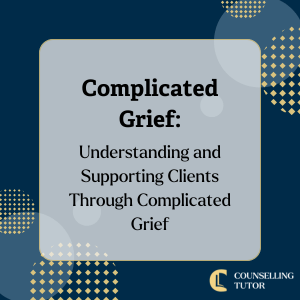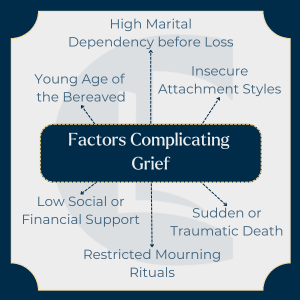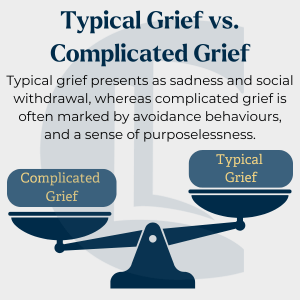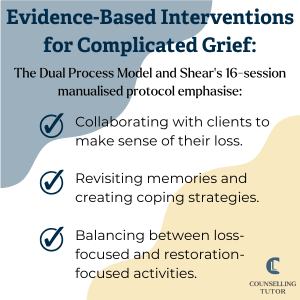Your Free Handout
Understanding and Supporting Clients Through Complicated Grief
Grief is an intricate and deeply personal journey, yet it becomes more complex in some circumstances, greatly impacting individuals. As a counsellor or psychotherapist, recognising the factors transforming normal grief into complicated grief is pivotal to providing practical support. Sudden, unexpected losses – such as those caused by natural disasters, accidents, or pandemics – pose unique challenges, complicating the bereavement process and the healing trajectory.
This article explores the intricacies of complicated grief, equipping practitioners with insights to assess, identify, and address the needs of clients facing this unique psychological burden.

Understanding and Supporting Clients Through Complicated Grief
By the end of this article, you will:
Certain adverse circumstances elevate the risk of complicated grief. Sudden or traumatic deaths, including those resulting from accidents, suicide, or violence, often complicate a bereaved person’s ability to process loss. Additionally, restricted mourning rituals, such as those experienced during the COVID-19 pandemic, can hinder closure and the formation of continuing bonds with the deceased.
Key risk factors include:


Understanding the difference between standard and complicated grief is essential for effective intervention. Typical grief encompasses emotional, cognitive, and behavioural reactions such as sadness, yearning, and social withdrawal. In contrast, complicated grief persists beyond 12 months, often marked by disruptive thoughts, avoidance behaviours, and a sense of purposelessness.
Approximately 10-15% of bereaved individuals experience chronic grief requiring professional support. It’s essential to discern whether counselling will be beneficial, as research highlights that interventions may inadvertently harm resilient individuals.
The Dual Process Model by Stroebe and Schut (1999, 2010) and Shear’s 16-session manualised protocol are pivotal frameworks for treating complicated grief. These approaches emphasise:
A pluralistic approach also allows tailored interventions, acknowledging that grief experiences and recovery pathways are deeply individual.

Practitioners must integrate sensitivity, adaptability, and evidence-based strategies into their practice to effectively support clients through their grief journey.
Even if you have experienced a similar type of loss, it’s essential to avoid projecting your grief journey onto the client. Assumptions about how someone “should” grieve can undermine the therapeutic relationship and hinder the client’s progress.
Instead:
Grief does not occur in a vacuum; it is deeply influenced by the client’s cultural and religious background. Misunderstanding or dismissing these contexts risks alienating the client and undermining the counselling process.
To work sensitively:
Collaboration lies at the heart of effective grief counselling. By involving the client in shaping their therapeutic journey, you empower them and respect their autonomy.
Practical ways to encourage collaboration include:
Effective grief counselling is not about providing answers but creating a space where clients can make sense of their loss.
Recognise that no single method works for everyone. A pluralistic attitude allows adjustments based on the client’s evolving needs and preferences.
Key elements include:
Understanding and Supporting Clients Through Complicated Grief
Normal grief includes sadness, yearning, and social withdrawal that ease over time. Complicated grief lasts over 12 months and involves persistent distress, avoidance, and difficulty moving forward.
Complicated grief is more likely after sudden or traumatic loss, restricted mourning rituals, or when the bereaved has insecure attachment, low support, or was highly dependent on the deceased.
Therapists can use frameworks like the Dual Process Model and Shear’s protocol, while staying flexible, culturally sensitive, and collaborative to tailor support to each client’s unique grief experience.
Supporting clients through complicated grief requires sensitivity, insight and a commitment to practical, client-centred strategies. Recognising the diverse factors that can complicate grief – and tailoring interventions to address these specific challenges – enables practitioners to guide clients through their unique grieving processes. By combining evidence-based approaches with an appreciation for each client’s individuality, you can help them make sense of their loss, develop coping mechanisms, and move toward a more hopeful future.

Effective grief counselling is not about following a rigid formula but building a collaborative, adaptable relationship that honours the client’s experience and supports their capacity for resilience. This practical focus equips you to refine your practice, ensuring that your work is compassionate and impactful. Ultimately, you empower clients to navigate their grief in ways that resonate with their journey.
Bonanno, G. A. (2010). The Other Side of Sadness: What the New Science of Bereavement Tells Us About Life After Loss. New York: Basic Books.
Shear, K. (2015). Complicated Grief Treatment Manual. New York: Columbia Center for Complicated Grief.
Stroebe, M. S., & Schut, H. (2010). The Dual Process Model of coping with bereavement. Omega: Journal of Death and Dying.
Wilson, J. (2022). Understanding How Adverse Circumstances Can Complicate Grief [lecture]. Counselling Tutor.
Counselling Tutor provides trusted resources for counselling students and qualified practitioners. Our expert-led articles, study guides, and CPD resources are designed to support your growth, confidence, and professional development.
👉 Meet the team behind Counselling Tutor
Notice any broken link or issues with this resource? Kindly let us know by email
Email us